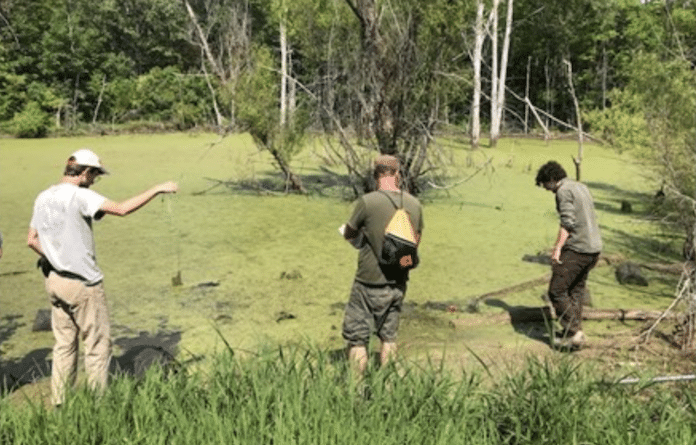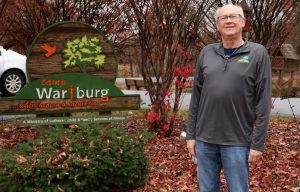How are there fish here?

By JOSHUA D. HOLBROOK
Clemson University
You walk through the woods, seeing a distinctive clearing up ahead, only to find yourself taking in the view of a woodland pond.
Perhaps there are grasses and rushes along the edge and some lily pads in the deeper water. If you’re a fisherman, it might occur to you to get your line wet: these backwoods ponds sometimes have the best fishing action.
But why? How on earth did this pond in the middle of the woods get fish in it?
That’s where my dissertation research comes in, and what brought me to southwestern Illinois and sites across two continents, including Connecticut, the Carolinas, Florida, and the South American nations of Peru and Paraguay. I wanted to know how, exactly, ponds and wetlands end up with fish, those poor vertebrates that find themselves on the wrong side of the evolution of legs, and thus have a hard time traversing uplands.
For most bodies of water, the answer is obvious: if the pond is connected to other bodies of water by rivers and stream.
No problem, so I specifically focused on hydrologically isolated bodies of water. In other words, ponds and wetlands that one could walk around and find no connections with streams, creeks or other water features.
There are three possibilities that may be occurring: maybe birds are bringing them in, maybe people are bringing them in, or perhaps flooding events are periodically allowing them to move in. The bird hypothesis is a little dubious. Some scientists have done experiments and found carp eggs could pass through birds’ digestive tracts unharmed, but there’s no direct evidence this is actually a mechanism for spreading fish around.
In Paul Wightman Subterranean Preserve, where most of my southern Illinois wetlands were located, the answer became very clear: only two of the nine sinkhole ponds we surveyed had fish.
One is the parking lot pond, the other is a pond on the edge of the preserve right along a road. Both ponds had only one species of fish each, and both species are popular sportfish.
Fast forward to the end of surveys in over 120 wetlands in ponds, and the data back up what I saw at PWSP: fish get into isolated wetlands via flooding, but in hilly landscapes (or landscapes with high topographic heterogeneity in ecology lingo). The only ponds that have fish tend to be the ones that have had a human helping hand.
Give a man a fish, and he’ll eat for a day. Give a pond a couple fish, and he’ll eat for a lifetime.
The logical next step is to ask what, exactly, these fish do to the other stuff in the wetlands when they show up: frogs, salamanders and insects.
I also addressed this question at PWSP, but you’ll have to join me Oct. 12 if you want that answer.
I’ll lead a presentation of my research from 1-3 p.m. Oct. 12 at the Monroe County Annex, 901 Illinois Avenue, Waterloo. This event is free and open to the public.
CLIFFTOP, a local nonprofit organization, is focused on preserving and protecting area bluff lands. For more information, visit clifftopalliance.org or contact cliffmbr@htc.net.






